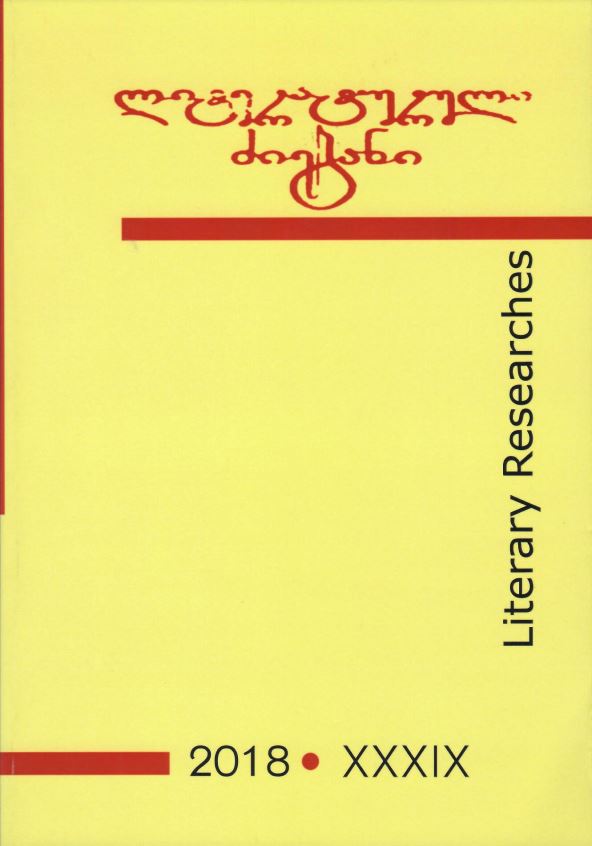გამოქვეყნებული 2018-12-20
საკვანძო სიტყვები
- Folktale,
- Epic,
- Literature,
- Oral Tradition,
- Motif
როგორ უნდა ციტირება
ანოტაცია
In Georgian folklore, there are many examples of oral versions of the literary works: the adaptations of national literature as well as translated literature. The interaction between literacy and orality is one of the most difficult problems in the study of folklore, literary theory and medieval researches as well. This article is a part of the research project “Orient and Occident in Georgian Folktales: Oral and Literary Traditions”, supported by the Shota Rustaveli National Science Foundation, Georgia [FR 217488]. In the folktale study there are some important aspects to be considered, including intertextual aspects of the folktale.
From this point of view, the tale of Rostom is worthy of note. Georgian epic “Rostomiani” is a folkloric version of the Georgian translation of Ferdowsi’s poem “Shahnamah”. The motif
about the fight between a father and his son represents the fight between two generations. This motif is very common in medieval literary and oral traditions. The father and the son face each other and prepare for the imminent battle. They met in the neither knowing the true name of his opponent. After a very long and heavy bout of wrestling, the father kills his son. In Europe and in the Middle East there are numerous literary and oral stories of the tragic encounter in battle between a son and his unrecognized father. This motif and its variants are well-known in all regions of Caucasus.
The motif of the father-son fight is one of the international motifs in Georgian folklore, which relatively could be called as “eternal recognized tale type”. However, Rostom’s intertextual links go quite far. In Georgian folklore, the figure of Rostom switches between the genres: legends, mythological tales, magic tales, didactic tales. Moreover, in Georgian oral narrative traditions, Rostom is an author of several philosophical aphorisms. Some of these aphorisms have literary origins, but some of them are folkloric.
For the clarification of methodological backgrounds, the intertextual nature of folklore is to define. Every folktale in a narrative tradition is a link, appearing in any number of versions. Even the famous scheme by Vladimir Propp bear the germs of intertextuality. The features indicated by the theory of intertextuality have already been there in different folk texts, but those features were not categorized as intertextuality then. Recent researches confirm that folklore can be said to be intertextual by definition. As Eli Yassif sees it, “the true importance of intertextuality lies in its contribution to the complextity of the text. The presence of secondary textual elements that are incorporated into the primary text but do not interfere with its ideological and aesthetic independence creates the powerful effect of multiple layers and meanings” (Yassif 2009: 71).
This article examines the archival material of the folkloric versions of the medieval epic,recorded in the late nineteenth to twentieth centuries in Georgia: the unpublished texts are found in the Folklore Archive of Shota Rustaveli Institute of Georgian Literature and in the Archive of the Folklore State Centre of Georgia.
These stories have folkloric origins, related with the motifs Mot.F531.1.0.1.1 [Beautiful giantess], Mot.F302.4 [Man obtains power over fairy mistress], Mot.F531.6.8.3.3. [Giants wrestle with each other], Mot.F531 [A person of enormous size] etc.
The narrators of fairy-tale-versions of the epic tales know these epics perfectly, possibly both literary and oral versions of The Knight in the Panther’s Skin and Shahname too. The stories of the epic heroes with the fairy-tale elements could be regarded as intertextual. The purpose of these stories purpose are usually didactic. The storyteller uses the earlier sources – medieval literature, both national and translated. These sources are not only narrative materials, but they are references too, which can bring various meaning to his text. This is a an intertextual system in which a new text is created through the interaction between earlier textual and new elements.

